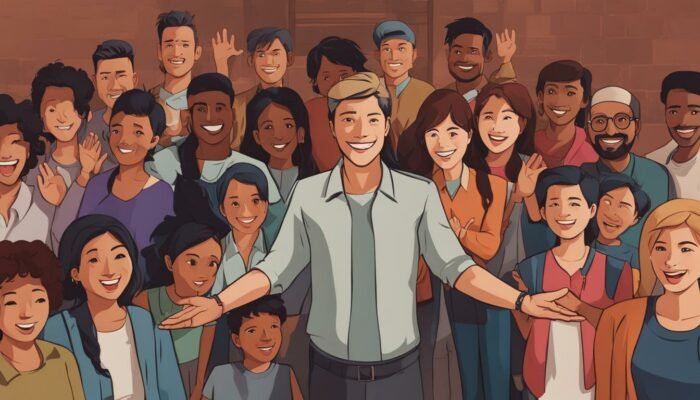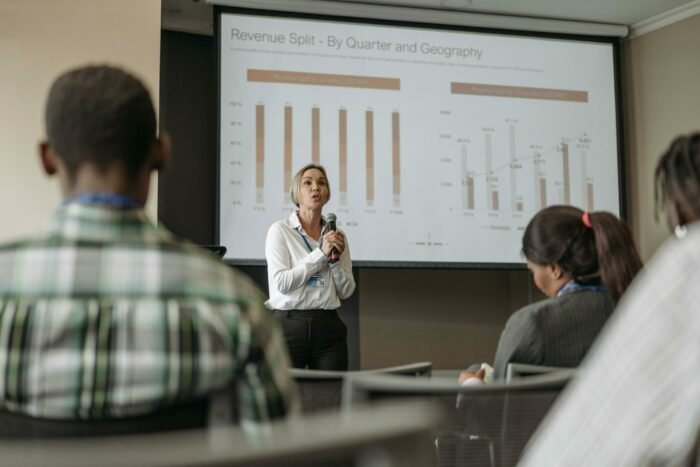Managing a multigenerational team can be both challenging and rewarding. Each generation in the workforce brings unique perspectives, work styles, and expectations. By understanding and addressing the characteristics of each generation, and embracing age diversity, organizations can benefit from increased employee performance, improved company performance, and enhanced knowledge sharing.
Key Takeaways:
- Understanding the characteristics of each generation is crucial for managing multigenerational teams effectively.
- Addressing ageism and embracing age diversity can create a more inclusive and supportive work environment.
- Educating teams about the benefits and challenges of a multigenerational workforce can foster awareness and understanding.
- Establishing respect for each generation’s values and work styles is vital for successful team management.
- Offering flexible solutions to meet the diverse needs of each generation can enhance employee satisfaction.
Effective Tips for Managing Multigenerational Teams
Combatting Ageism and Embracing Age Diversity
Ageism, or age discrimination, is a significant issue in the workplace. It is crucial for managers to address generational differences and treat all employees, regardless of their age, fairly and equally. By addressing these differences head-on, companies can leverage generational diversity for team success and bridge the generation gap.
Creating an Inclusive Work Environment
Embracing age diversity as part of a company’s diversity, equity, and inclusion efforts can create an inclusive and supportive team environment. Recognizing and celebrating the unique contributions and perspectives of each generation can foster collaboration and team success. By fostering understanding and respect among different age groups, companies can promote a sense of belonging and teamwork.
Breaking Down Stereotypes
One of the first steps in combatting ageism is breaking down stereotypes associated with different generations. Stereotypes can create barriers and hinder effective teamwork. By encouraging open dialogue and providing opportunities for individuals to showcase their skills and talents, companies can challenge these stereotypes and cultivate a more inclusive work culture.
“Age is just a number, and diverse perspectives stemming from various generations can drive innovation and success in a team.”
Leveraging the Strengths of Each Generation
Every generation brings unique strengths and experiences to the table. By leveraging the strengths of each generation, companies can create a dynamic and high-performing team. For example, older generations may have valuable wisdom and experience, while younger generations may bring fresh ideas and technological expertise. Recognizing and harnessing these strengths can lead to greater innovation and productivity.
Creating Opportunities for Collaboration
To bridge the generation gap, it is important to create opportunities for collaboration among employees from different age groups. This can be achieved through cross-generational mentorship programs, diverse project teams, and team-building activities. By fostering an environment where individuals learn from one another, companies can tap into the collective knowledge and skills of their multigenerational workforce.
| Generational Differences | Benefits of Age Diversity |
|---|---|
| Varied work styles and preferences | Increased creativity and innovation |
| Different technological proficiency | Enhanced problem-solving capabilities |
| Unique perspectives and experiences | Improved decision-making processes |
| Varied career aspirations and goals | Inclusive and balanced decision-making |
By actively addressing generational differences in the workplace, companies can create a more inclusive and harmonious work environment. Embracing age diversity, leveraging the strengths of each generation, and fostering collaboration can contribute to team success and overall organizational growth.
Tips for Managing a Multigenerational Workforce
To effectively manage a multigenerational workforce, I have gathered some valuable tips that can help improve leadership effectiveness, communication, and teamwork across generations.
Educate your team about the benefits and challenges
Creating awareness and understanding is key to managing a multigenerational workforce. Take the time to educate your team about the advantages that come with diverse perspectives, experiences, and ideas. Emphasize the importance of embracing age diversity and highlight the potential challenges that may arise.
Establish respect for each generation’s values and work styles
Recognizing and respecting the different values and work styles of each generation is vital for fostering a harmonious work environment. Encourage open discussions where employees can share their values and preferences, promoting understanding and empathy among team members.
Focus on the big picture and company goals
Instill a sense of camaraderie by reminding your team of the bigger picture and how each individual contributes to the overall success of the company. Highlight the value that each generation brings to the table and emphasize the importance of working together towards common goals.
Encourage learning from one another
Mentorship programs and diverse project teams can be effective in promoting knowledge sharing and problem-solving across generations. Encourage older employees to share their expertise and experiences with younger colleagues, while also providing opportunities for younger employees to contribute fresh perspectives and innovative ideas.
Fight age bias and stereotypes
Creating an inclusive work environment starts with addressing age bias and stereotypes. Foster a culture that values individuals based on their skills, abilities, and contributions, rather than their age. Encourage open conversations about age-related stereotypes and take proactive measures to combat them.
Offer flexible solutions
Recognize that each generation may have different needs and preferences when it comes to work arrangements. Consider implementing flexible work options, such as remote work or flexible hours, to accommodate the diverse requirements of your multigenerational workforce. This can enhance employee satisfaction and promote work-life balance.
Recognize the similarities that exist across generations
While each generation has its unique characteristics, it is essential to acknowledge the commonalities that transcend generational boundaries. Foster an environment that celebrates shared values, aspirations, and goals, ensuring that the focus remains on collaboration and finding common ground.
I hope these tips will help you effectively manage your multigenerational workforce, resulting in improved leadership, enhanced communication, and stronger teamwork across generations.
The Importance of Effective Communication and Trust
Effective communication is crucial when managing a multigenerational team. Understanding and adapting to different communication styles and preferences can minimize misunderstandings and conflicts. By fostering intergenerational communication, teams can collaborate more efficiently and achieve better results.
Building trust among team members, regardless of their generational differences, is essential for successful collaboration. Trust creates a strong foundation for teamwork and enables open and honest communication. It is through trust that diverse teams can truly thrive and unleash their full potential.
Regular check-ins and team meetings provide opportunities for direct communication and alignment. Active listening plays a vital role in understanding the needs and perspectives of team members from different generations. By creating a safe space for open dialogue, managers can encourage the sharing of ideas, thoughts, and concerns.
Intergenerational learning is another way to foster communication and build trust within diverse teams. The younger generations can benefit from the wisdom and experience of older team members, while the older generations can learn new perspectives and innovative approaches from younger team members. Creating a culture of continuous feedback and growth enhances communication and allows teams to adapt and thrive in an ever-changing work environment.
Benefits of Effective Communication and Trust:
- Promotes collaborative teamwork and synergy among team members
- Reduces conflicts and misunderstandings resulting from generational differences
- Increases employee engagement and satisfaction
- Enhances knowledge sharing and learning across generations
- Fosters innovation and creativity in problem-solving
In conclusion, effective communication and trust are integral elements in managing multigenerational teams. By leveraging leadership skills that prioritize intergenerational communication and empowerment, managers can foster an inclusive work environment that values diverse perspectives and experiences. This, in turn, leads to stronger teamwork, improved productivity, and overall team success.
Conclusion
Managing a multigenerational team effectively requires a deep understanding of the unique characteristics, values, and perspectives of each generation. By addressing ageism in the workplace and embracing age diversity, organizations can foster an inclusive and supportive environment that enables all employees to thrive. Implementing strategic leadership practices, improving communication channels, and promoting collaboration across generations are key strategies for achieving team success and maximizing company performance.
Effective team management involves leveraging the strengths and expertise of each generation within the workforce. By recognizing and valuing the diverse skills and experiences that different generations bring to the table, organizations can create a collaborative and innovative multigenerational workforce. Encouraging team collaboration, open communication, and mutual respect are fundamental in building trust and fostering a positive work culture.
Leadership in a multigenerational workforce requires adaptability, flexibility, and the ability to bridge generational differences. Effective leaders understand the importance of tailoring their management approach to meet the needs and preferences of each generation. By embracing a proactive mindset and implementing strategies for managing multigenerational teams, leaders can position their organizations for long-term success in a rapidly evolving business landscape.
FAQ
What is a multigenerational team?
A multigenerational team is a team that consists of individuals from different generations, such as the silent generation, baby boomers, Generation X, millennials, and Generation Z.
What are the benefits of managing a multigenerational team?
Managing a multigenerational team can lead to higher employee performance, improved company performance, and increased knowledge sharing.
How can I combat ageism in the workplace?
To combat ageism, it is important to treat all employees, regardless of their age, fairly and equally. Embracing age diversity and recognizing the value that each generation brings can create an inclusive and supportive team environment.
What tips can help me effectively manage a multigenerational workforce?
Tips for effectively managing a multigenerational workforce include educating your team about the benefits and challenges, establishing respect for each generation’s values and work styles, focusing on the big picture, learning from one another through mentorship and diverse project teams, fighting age bias and stereotypes, offering flexible solutions, and recognizing the similarities that exist across generations.
How can I improve communication in a multigenerational team?
To improve communication in a multigenerational team, it is important to understand and adapt to different communication styles and preferences. Building trust among team members, regular check-ins, active listening, creating opportunities for open dialogue, encouraging intergenerational learning, and fostering a culture of continuous feedback and growth can also enhance communication.











